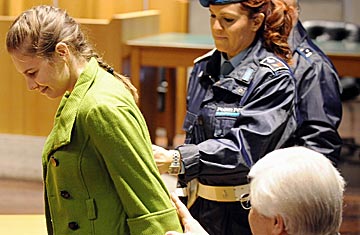
American student Amanda Knox in court in Perugia, Italy, on Dec. 4
Shouts of "Assassina Americana!" rang across the cobbled streets in the historic center of Perugia on Friday night, as journalists and citizens jostled to watch a midnight court session that completed the controversial murder trial of American college student Amanda Knox. Along with her Italian former boyfriend Raffaele Sollecito, Knox was accused of the Nov. 1, 2007, killing of her British roommate Meredith Kercher who, like Knox, was spending a year studying abroad.
With her family standing behind her, a shaking and tearful Knox, 22, watched the three men and three women of the jury and two judges file in after 12 hours of deliberation, their faces unreadable, as they had been throughout most of the 11-month trial. As the judge read the guilty verdict, Sollecito's stepmother began to sob loudly and then shouted "Va fancula," "F___ you" in Italian. That alarm, rather than the judge's actual words, first indicated Knox's fate to her family, because none of them speak Italian.
The jury sentenced Knox to 26 years and Sollecito to 25 years, less than a life sentence and with a period of isolation the prosecutor had requested; Knox may have received the extra year for the added conviction of slander for having initially accused a local bar owner of the murder. As she was led back to prison, Knox's wails could be heard through the brick walls of the medieval court building. Sollecito, who throughout the trial had been more emotional than Knox, went pale but did not react.
Eleven hours later, the Kercher family held a press conference in Perugia to thank the Italian prosecutors and police. Like the Knoxes, the Kerchers don't speak Italian, and an interpreter from the British consulate helped them respond to Italian reporters.
"I think the best way to say it is, we are very satisfied with the verdict," said John Kercher Jr., seated between his parents and Meredith's other surviving siblings Lyle and Stephanie. "Ultimately, we are pleased with the decision, but it's not time for celebration. We are gathered here because our sister was brutally murdered, taken away from us."
In recent days, defense lawyers had aggressively attacked both the validity of the material evidence in the case and the prosecution's lively theory of a "sex game gone wrong," but the Kercher family expressed no doubts. "I would say if the evidence has been presented, then you have to agree with that," said Arline Kercher, Meredith's mother. "At the end of the day, you have to go on the evidence. There is nothing else."
Knox's family and other supporters, however, say the evidence against her didn't amount to much. The theory that Knox hated Kercher and motivated two male admirers, Sollecito and Rudy Guede (already convicted in a separate trial of the murder), to restrain and sexually assault Kercher, while Knox drove a knife into her neck, was largely circumstantial. Guede's footprints and handprints were on the bloody scene and his DNA inside the sexually assaulted victim, but almost no similarly incriminating evidence linked the two students to the crime scene.
The most serious material evidence against Knox and Sollecito came down to two elements: a microscopic speck of Sollecito's DNA on a bra clasp that was apparently torn off Kercher's back during the savage attack and another microscopic speck of biological substance compatible with Kercher on a kitchen knife picked by police at random from Sollecito's drawers after his arrest, with Knox's DNA on the handle. Prosecutors say the two college students walked the knife back to Sollecito's house after spending a sleepless night at the crime scene scrubbing away their tracks. Defense lawyers presented experts who said the amounts of biological material were too small to be verified, and could have been the result of contamination either at the crime scene or in the lab.
Key elements such as motive and even timing shifted during the trial. During closing arguments, prosecutors changed the estimated time of death, pushing it two hours later in order to better match the account of a homeless man who came forward months after the arrests and claimed to have seen Sollecito and Knox hovering near the house where Kercher was stabbed to death on the night after Halloween 2007. Knox lived in the house, while Sollecito's apartment was a five-minute walk away. Prosecutor Giuliano Mignini, in rebuttal arguments, reminded the judges and jurors that if they decided to acquit the two students, they would be reversing opinions by more than 10 preliminary judges and magistrates who had accepted his theory during the investigation.
